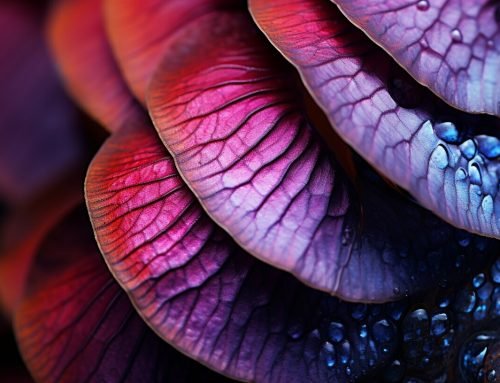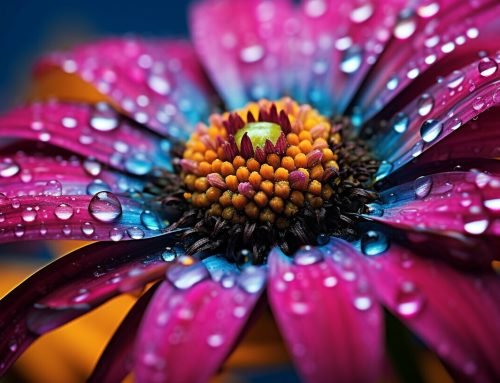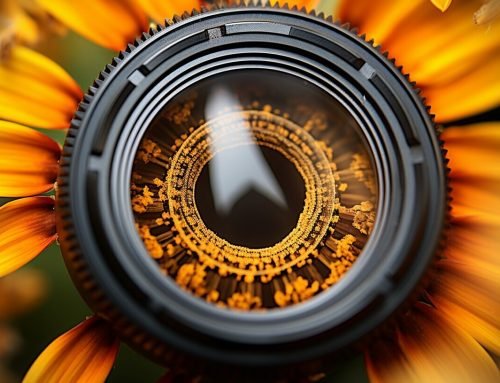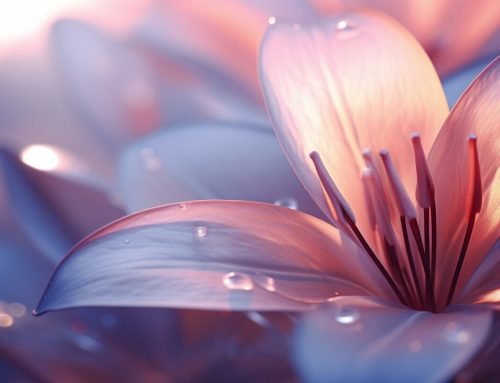
Macro photography is a mesmerizing technique that allows you to capture the intricate details of small subjects in breathtaking detail. It requires attention to detail, patience, and working with shallow depths of field and long shutter speeds. Whether you are a beginner or an experienced photographer, mastering the art of macro photography can open up a whole new world of creative possibilities.
Key Takeaways:
- Macro photography is about capturing small objects and making them appear larger than life.
- The lens is a crucial component in macro photography, offering various options like macro lenses, macro bellows, macro filters, and extension tubes.
- Accessories like tripods, focusing rails, and DIY light boxes can enhance your macro photography.
- Experimenting with angles, lighting, and color can create unique and visually appealing macro photos.
- Macro nature photography provides endless subject ideas, allowing you to explore the beauty of the natural world.
Now, let’s dive deeper into macro photography and uncover the tips and tricks to enhance your skills and unlock the true magic of this captivating technique.
Understanding Macro Photography: A Close-Up Perspective
Macro photography involves capturing small objects and making them appear larger than life, revealing the hidden beauty that often goes unnoticed. This technique requires attention to detail, patience, and the ability to work with shallow depths of field and long shutter speeds. Whether you are a beginner or an experienced photographer, macro photography offers a fascinating way to explore the intricacies of the world around us.
To delve into macro photography, you will need the right equipment. DSLRs, mirrorless cameras, and even point-and-shoot models specifically designed for macro photography can all be used. However, the lens is critical in achieving impressive macro shots. Various options include general and dedicated macro lenses specifically designed for close-up photography. If you are on a budget, you can experiment with inexpensive alternatives such as macro bellows, macro filters, and extension tubes, which can be used with your existing lenses to achieve macro effects.
Once you have the equipment, it’s time to explore the endless possibilities of macro photography. You can capture everyday objects like pencils and toys or focus on the intricate details of nature, such as water droplets on leaves, feathers, bubbles, or even the mesmerizing patterns of an eye. The key is experimenting with different angles, lighting conditions, and colors to create visually stunning images. Manual focus is often recommended for macro photography, allowing for more control and precision. Paying attention to the depth of field and purposely choosing the focus point in your images will result in captivating macro shots.
Macro photography offers a therapeutic and creative outlet to appreciate the beauty of small subjects that often go unnoticed. With the right equipment, techniques, and a keen eye for detail, you can unlock the magic of macro photography and capture stunning close-ups that will amaze and delight viewers.
| Key Points: |
|---|
| Macro photography involves capturing small objects and making them appear larger than life. |
| The lens is a crucial component in macro photography, with various options available. |
| Experimenting with angles, lighting, and color is essential to create visually appealing macro photos. |
| Manual focus and attention to depth of field are recommended for achieving precise macro shots. |
Choosing the Right Equipment for Macro Photography
The right equipment is paramount in macro photography, and it starts with choosing the appropriate lens and accessories for your specific needs. Regarding macro lenses, various options are available, each with its advantages. General macro lenses are versatile and can be used for a wide range of macro subjects, from tiny insects to detailed textures. On the other hand, Dedicated macro lenses are specifically designed for close-up photography and offer exceptional image quality and magnification. Depending on your budget and preferences, you can opt for prime lenses or zoom lenses, with focal lengths ranging from 50mm to 200mm.
In addition to the lens, other accessories can enhance your macro photography experience. Tripods are essential for keeping your camera steady and minimizing blur, especially when using slow shutter speeds. Focusing rails allow for precise and controlled movements, enabling you to fine-tune the focus and capture intricate details. DIY light boxes can create diffused and even lighting, eliminating harsh shadows and enhancing the overall quality of your macro photos.
Table: Different Types of Macro Lenses
| Macro Lens Type | Description |
|---|---|
| General Macro Lens | Versatile lens suitable for a wide range of macro subjects |
| Dedicated Macro Lens | Specifically designed for close-up photography, offering exceptional image quality and magnification |
| Prime Lens | A fixed focal length lens that provides excellent image quality and is typically more affordable |
| Zoom Lens | A lens with variable focal lengths, providing versatility and convenience |
When choosing your macro equipment, it’s important to consider your specific needs and preferences. Consider factors such as your budget, the subjects you intend to photograph, and the level of magnification you desire. Ultimately, the right equipment will enable you to capture stunning and detailed macro shots, unlocking the magic of this fascinating genre of photography.
Mastering Macro Techniques for Stunning Shots
To capture truly stunning macro shots, it’s essential to master a variety of techniques that bring out the beauty of your subjects in unique ways. Whether you’re photographing delicate flowers, intricate insects, or tiny details of everyday objects, these techniques will help you create visually captivating images.
Experiment with Angles
One of the key aspects of macro photography is finding interesting and unexpected angles to capture your subjects. Instead of shooting straight-on, try getting down low and shooting from a worm’s eye view or experiment with overhead shots. Changing your perspective can reveal intricate details and add an artistic touch to your photos.
Play with Lighting
Lighting is crucial in macro photography as it helps emphasize the textures and details of your subjects. Natural lighting, such as soft morning light or diffused light on an overcast day, can create a beautiful glow and add depth to your images. Additionally, you can experiment with artificial lighting, such as a ring or a small LED light, to highlight specific areas or create interesting shadows.
Embrace Colors
Macro photography provides the perfect opportunity to explore vibrant colors and unique color combinations. Please pay attention to the colors in your subjects and find ways to make them pop. Consider using complementary colors or contrasting hues to create visual impact. You can also experiment with different backgrounds and props to enhance the color palette of your images.
| Techniques | Examples |
|---|---|
| Focus Stacking | Combining multiple images with different focus points to create a final image with a greater depth of field. |
| Freeze Motion | Using a fast shutter speed to freeze the movement of a subject, such as a buzzing bee or a falling droplet of water. |
| Bokeh Effect | Creating a dreamy, out-of-focus background by using a wide aperture and focusing on a specific part of your subject. |
| Reflections | Exploring the play of light and reflections in your macro shots, such as capturing the reflection of a flower in a water droplet. |
Remember, macro photography is a journey of exploration and experimentation. Don’t be afraid to try new techniques and push the boundaries of your creativity. With practice and a keen eye for detail, you can capture stunning macro shots that showcase the incredible beauty of the small world around us.
Illuminating Your Macro World: Understanding macro lighting
Lighting plays a crucial role in macro photography, as it can dramatically enhance or detract from the overall impact of your images. The right lighting setup is essential when capturing small subjects’ intricate details.
One of the most common techniques used in macro lighting is natural light. It provides a soft, diffused illumination that can beautifully highlight the textures and colors of your subjects. To make the most of natural light, try shooting during the golden hours of sunrise or sunset when the light is warm and gentle. You can also experiment with the position of your subject about the light source to create interesting shadows and highlights.
Artificial lighting options such as ring lights, LED panels, and off-camera flashes are popular for those seeking more control over their lighting. These tools allow you to position the light exactly where you want it, enabling you to highlight specific details or create dramatic effects. Consider using diffusers or reflectors to soften the harshness of artificial light and achieve a more.
| Lighting Techniques | Pros | Cons |
|---|---|---|
| Natural Light | Soft, diffused illumination Beautiful textures and colors No additional equipment is required | Dependent on weather conditions Less control over lighting direction |
| Artificial Light | Greater control over lighting Ability to create dramatic effects Consistent illumination | Requires additional equipment It may require more technical knowledge It can be harsh if not diffused |
Regardless of the lighting technique you choose, it’s important to consider the color temperature of your light source. Different light sources have different color temperatures, which can significantly impact the mood and appearance of your photos. For example, natural light tends to have a warm, golden tone during sunrise and sunset, while artificial lights can vary in color and temperature depending on the settings.
Experimenting with different lighting setups and techniques is key to discovering your own unique style in macro photography. Don’t be afraid to play around with angles, shadows, and colors to create visually captivating images that showcase the intricate beauty of small subjects.
Expanding Your Macro Photography Toolkit
In addition to the essential macro equipment, several other tools and accessories can take your macro photography to the next level. These additional tools enhance the technical aspects of your photography and provide you with more creative opportunities to explore. Here are some must-have accessories for your macro photography toolkit:
- Macro Bellows: A macro bellow is a flexible extension tube that can be attached between your camera body and lens, allowing for even greater magnification capabilities. It provides more flexibility and versatility in adjusting the distance between your camera and subject, enabling you to capture stunning close-up shots.
- Macro Filters: Macro filters are affordable alternatives to macro lenses. These screw-on filters attach to the front of your existing lens, reducing the minimum focusing distance and increasing magnification. They come in different magnification strengths, allowing you to experiment with various levels of close-up photography.
- Extension Tubes: Extension tubes are hollow tubes placed between your camera and lens, moving the lens further away from the camera sensor. This extension increases the magnification power, enabling you to capture detailed macro shots without needing dedicated macro lenses.
Aside from these accessories, having a sturdy tripod is crucial for macro photography. It allows you to stabilize your camera and keep it steady during long exposures, ensuring sharp and blur-free images. Investing in a tripod with a flexible ball head and adjustable height can provide maximum shooting flexibility and convenience.
DIY Light Box for Macro Photography
Creating a DIY light box can significantly enhance your macro photography. A light box is a simple and cost-effective solution for achieving soft and diffused lighting that eliminates harsh shadows and highlights the details of your subject. To make a light box, all you need is a cardboard box, white tissue paper or tracing paper, and a light source. Cut out openings on the sides of the box, cover them with the paper, and place the light source outside the box. This setup allows the light to pass through the diffusing paper, creating a soft and even illumination for your macro subjects.
By expanding your macro photography toolkit with these accessories and incorporating DIY techniques, you can unlock a whole new world of creative possibilities. Whether you’re capturing everyday objects, nature’s intricate details, or unique compositions, these tools will help you elevate your macro photography skills and capture stunning images that showcase the beauty of the small.
| Must-Have Accessories for Macro Photography |
|---|
| Macro Bellows |
| Macro Filters |
| Extension Tubes |
Exploring the Beauty of Macro Nature Photography
Nature provides a wealth of opportunities for macro photography, allowing you to delve into the mesmerizing world of flowers, insects, and other small wonders. The intricate details and vibrant colors in nature make it a perfect subject for macro photography. Whether you’re capturing the delicate petals of a flower, the iridescent wings of a dragonfly, or the textures of a leaf, macro nature photography offers endless possibilities for creative exploration.
When photographing nature up close, it’s essential to approach your subjects carefully and respectfully. Take your time to observe the natural environment and find issues that catch your eye. Look for interesting patterns, textures, and colors to add visual interest to your macro photographs. Remember to use a tripod or other stabilization techniques to ensure sharpness and minimize camera shake, especially when shooting near your subject.
Subject Ideas for Macro Nature Photography
- Flowers: Capture the intricate details of petals, stamens, and pollen grains. Experiment with different angles and perspectives for unique compositions.
- Insects: Get up close and personal with butterflies, bees, ladybugs, and other fascinating insects. Focus on their eyes, wings, and intricate patterns.
- Leaves: Explore the textures, veins, and colors of various leaves. Look for interesting lighting and shadows to enhance the visual appeal.
- Dewdrops: Capture the magical world of dewdrops on grass, leaves, or flower blades. Play with reflections and refractions for stunning effects.
- Feathers: Showcase the intricate patterns and vibrant colors of bird feathers—experiment with backlighting to reveal the details.
- Water droplets: Explore the mesmerizing world of water droplets on surfaces like flower petals or spiderwebs. Play with light and focus to create dreamy images.
Remember, macro nature photography is all about capturing the small details that often go unnoticed. Take your time to explore different settings, angles, and lighting conditions to bring out the beauty of your subjects. Remember to respect the environment and its inhabitants by not disturbing or causing harm to the delicate ecosystems you’re photographing. With patience, creativity, and a keen eye for detail, macro nature photography can transport you to a world of intricate, breathtaking beauty.
| Subject | Technique | Tips |
|---|---|---|
| Flowers | Focus on the details of petals, stamens, and pollen grains. | Experiment with different angles and perspectives for unique compositions. Consider using a shallow depth of field to create a blurred background and isolate the subject. |
| Insects | Capture the intricate patterns and textures of insects. | Find interesting angles and use a fast shutter speed to freeze their movements. Look for natural lighting conditions that accentuate the details. |
| Leaves | Highlight the textures, veins, and colors of leaves. | Experiment with different lighting angles and consider backlighting to create a translucent effect. Look for leaves with interesting patterns or unique shapes. |
Conclusion
Macro photography offers an enchanting journey into the fascinating world of small subjects, allowing you to unlock their magic and capture their intricate beauty. This technique involves capturing small objects and making them appear larger than life, demanding attention to detail, patience, and the ability to work with shallow depths of field and long shutter speeds.
To delve into macro photography, you need the right equipment. DSLRs, mirrorless cameras, and point-and-shoot models specifically designed for macro photography can all be used. The lens plays a crucial role, and various options are available, including general and dedicated macro lenses. If you’re on a budget, you can explore inexpensive alternatives such as macro bellows, macro filters, and extension tubes.
Enhancing your macro photography experience is possible by adding accessories like tripods, focusing rails, and DIY light boxes. These tools enable excellent stability, precision, and control, resulting in stunning macro shots.
When it comes to subject matter, the possibilities are endless. Everyday objects like pencils and toys, water droplets on a CD, leaves, feathers, bubbles, matchsticks, and even eyes can become captivating subjects in macro photography. Experimenting with angles, lighting, and color is critical to creating unique and visually appealing images.
Manual focus is recommended for macro photography as it provides more control and accuracy. Attention to the depth of field and purposefully choosing the amount of stress in your images is essential. Macro photography offers a creative outlet and a therapeutic activity, allowing you to immerse yourself in the intricate details of small subjects.
FAQ
What is macro photography?
Macro photography is a technique that involves capturing small objects and making them appear larger than life.
What equipment do I need for macro photography?
Macro photography can be achieved with different equipment, including DSLRs, mirrorless cameras, and point-and-shoot models specifically designed for macro photography. The lens is a crucial component, and various options are available, including general and dedicated macro lenses. Inexpensive options include using macro bellows, macro filters, and extension tubes.
Any tips for capturing unique macro photos?
Experiment with angles, lighting, and color to create unique and visually appealing macro photos. Try capturing everyday objects like pencils and toys, water droplets on a CD, leaves, feathers, bubbles, matchsticks, and eyes.
Should I use manual focus for macro photography?
Manual focus is recommended for macro photography as it provides more control and accuracy.
What should I consider when it comes to depth-of-field in macro photography?
Attention to depth-of-field and purposefully choosing the amount of focus in your images is essential in macro photography.
Is macro photography therapeutic?
Yes, macro photography offers a therapeutic and creative way to capture the intricate details of small subjects.






